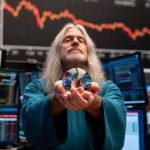Trapdoor: The Sudden Drop
May 1, 2025
Stop. This isn’t the safe, sedated world you thought you’d entered. The floor beneath your feet is a membrane, thin, trembling with quantum uncertainty. One false move, and you’re falling through it. That’s the nature of this construct. Market volatility meaning isn’t a glossary entry. It’s what happens when the ground vanishes, the centre cannot hold, and the map you trusted is suddenly a Mobius strip. Most choose denial, seeking comfort in averages, in means, in a world where risk is Gaussian and gentle. But out here, at the edge, truth arrives as a trapdoor—unexpected, pitiless, final. Volatility is not noise. It is signal—a siren blaring in the language of price. The market doesn’t care about your models or your hope. Volatility is the moment the mask drops, the game reveals its teeth, and the crowd realises they were never in control. It is the instant a single atom decays, unleashing a chain reaction that scrambles the entire field. Investors who ignore this—who believe in smooth paths—are already lost.
Superposition: The Many Worlds in Play
In the quantum realm, particles don’t pick a lane. They occupy every possible state, a blur of probabilities collapsing only when observed. So too with the market volatility meaning. It is not one thing, not a simple up or down. It is every possible reality—profit, ruin, stasis—held in tension. One moment, capital surges like electrons tunnelling through a barrier; the next, it vanishes, annihilated by a misread headline or a microsecond algorithmic twitch. Investors see price. The few see phase shifts, inflexion points, the place where all certainties become paradox. There are no safe harbours, only shifting wave functions. Volatility is the market’s refusal to be pinned down, its declaration that the game is never played twice the same way. The meaning here is not in the numbers, but in the unmeasurable risk lurking in the collapsed states no one expected. Those who ride this chaos—who can play every world at once—are not gamblers, but physicists of profit.
Catalysts: The Unseen Reactions
Volatility is not a feature. It’s an emergent property—like fire from friction, or a chemical flash when two silent elements finally touch. The market volatility meaning reveals itself in the cracks: a central bank’s offhand remark, a rogue tweet, a geopolitical tremor. The chain reaction begins with a single unstable element—fear, greed, uncertainty—and ripples out, changing everything it touches. Most investors see the explosion; the rare few see the precursors, the molecules trembling before detonation. To understand this is to see the market not as a chart but as a living reaction chamber, where every participant is both observer and catalyst. There are those who wait for the storm to pass. And there are those who become the storm, harnessing volatility as fuel, turning chaos into advantage. In the end, volatility is not what destroys you. It’s what reveals who you really are in the crucible of the unknown.
Singularity: The Point of No Return
There is a moment- a singularity—when all models break. The market volatility meaning crystallises here, at the event horizon, where prediction fails and reality asserts itself. It’s the split-second when liquidity vanishes, spreads explode, and the game devolves into pure reaction. The crowd recoils. The bold advance. This is not bravado. It’s the discipline of those who have trained for the moment the centre cannot hold, who understand that volatility is both weapon and warning. It is the gravitational collapse of certainty, the birth of new structures from the debris of old. At the singularity, investors are no longer playing against one another. They are playing against the limits of their own nerve, their own insight, their own willingness to see through the chaos to the new order being born. This is not the end. It is the origin point of every new fortune and every legendary loss.
Shadow Mathematics: Reading the Invisible
The market volatility meaning is written in a language few can decipher. It hides in kurtosis, in fat tails, in the fractal patterns that only show themselves to those who know where to look. The market is a cypher—its volatility the code. The masses crave stability, but stability is an illusion. Volatility is the truth. It is the shadow mathematics, the calculus of crisis and opportunity. Those who see it walk through markets like codebreakers, sensing the invisible hand not as a comfort, but as a threat and a promise. They know that risk cannot be eliminated, only embraced and managed. Every spike, every crash, every anomaly is a message: adapt or evaporate. The market volatility’s meaning is not something to be explained, but something to be decoded, lived, and survived. In this game, only those who embrace the uncertainty read the shadows—emerge with their capital and their sanity intact.
Volatility Whisperer: The George Soros Gambit
When the conversation turns to those who have not merely survived but thrived on the razor’s edge of uncertainty, one name refracts through the chaos with relentless clarity: George Soros. In the lexicon of market volatility meaning, Soros is not a mere participant—he is an architect of upheaval, a trader who reads turbulence as scripture. Most famously, Soros is remembered for “breaking the Bank of England” in 1992, a move that crystallised the destructive and creative power of volatility in a single epochal bet. While others saw the British pound’s fluctuations as random noise, Soros perceived a structural weakness—misaligned currencies straining against the artificial order of the European Exchange Rate Mechanism. He understood volatility not as a hazard, but as a vector for insight, a signal that the market’s undercurrents were about to become tidal waves.
Soros’s quantum fund did not rely on hope or hubris; it harnessed the predictive patterns hidden in volatility’s apparent chaos. His approach was not to flee when the ground shook, but to move closer, to measure the amplitude and frequency of the tremors, and to calculate—sometimes with surgical precision, sometimes with audacious intuition—where the fracture would become a fault line. This was not speculation; it was strategy, a kind of financial jiu-jitsu that used the system’s own momentum against itself. The market volatility, meaning, for Soros, was less about fear and more about feedback loops: reflexivity, where perceptions shape reality, and reality loops back to rewrite perceptions.
In this domain, Soros stood apart from the herd, willing to bet billions where others clung to consensus. His legend is not just in the magnitude of his gains, but in his unflinching embrace of the unknown. For investors seeking to understand the market volatility meaning, Soros is the ultimate case study—a man who did not just weather the storm, but learned to chart its course, extract its energy, and, at times, become the storm itself.











